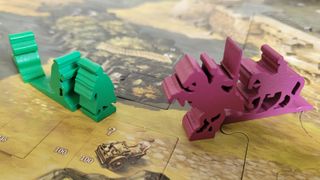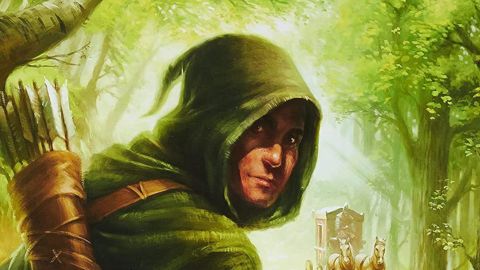GamesRadar+ Verdict
Although you could accuse it of being a narrative novelty, The Adventures of Robin Hood is clever and compelling enough to make players of any age fall in love with it.
Pros
- +
Novel movement and combat mechanics
- +
All-ages gameplay
- +
Very accessible
- +
Clever advent-calendar design
Cons
- -
Loses impact over time
- -
Lacks depth
- -
Repetitive
Why you can trust GamesRadar+
Who doesn’t love a bit of Robin Hood? The fresh air! The wealth redistribution! The young men in green tights! Certainly, the board game industry has been as much of a sucker for the charms of Sherwood Forest as the rest of us, with various titles of fair-to-middling quality having come and gone over the years.
The Adventures of Robin Hood promises to be something a bit different. It’s from designer Michael Menzel, the mind behind the cooperative family-friendly fantasy adventure Legends of Andor. He’s attempting to refashion Robin Hood in the same kind of image, as a narrative board game for families to enjoy with the group winning or losing together.
What is it, and how does it work?

- Game type: Narrative
- Players: 2 - 4
- Difficulty: Easy
- Lasts: 60 mins
- Ages: 10+
- Price: $59.99 / £36
- Play if you enjoy: The Princess Bride Adventure Book Game, Stuffed Fables
Right from opening the box, it’s clear that The Adventures of Robin Hood is doing something a bit different from the average board game. The “accompanying booklet” that outlines the rules actively exhorts you not to read it, but to refer to a single introductory sheet instead. This goes over the movement rules for the game which are quite novel.
Each character - there are four from the Robin Hood legends - comes with five wooden pieces. Two are standing, while the other three have long straight tails of various lengths. A standing piece marks the current position of the character, and to move, you lay as many of the others as you want end to end. You’re not allowed to move over walls, buildings or the depths of Sherwood, so you rotate the tailed pieces to manoeuvre around them. It’s a neat, intuitive and unusual way to progress across the map.
Speaking of which, the map itself comes in an unexpected sleeve. Once you slide it out, you’ll see why: it’s covered in advent calendar-like doors that you can pop up, flip over, and fit back in. The sleeve is to ensure they all stay in place. Most have a different illustration on the back and some have a reward underneath. They change frequently during play, giving the board state a real sense of dynamism as the people of Nottingham go about their daily business. There are a couple of hundred such doors, each with its own number, making the whole thing look all the more like an oversized Christmas novelty.

Speaking of which, the map itself comes in an unexpected sleeve. Once you slide it out, you’ll see why: it’s covered in advent calendar-like doors that you can pop up, flip over, and fit back in. The sleeve is to ensure they all stay in place. Most have a different illustration on the back and some have a reward underneath. They change frequently during play, giving the board state a real sense of dynamism as the people of Nottingham go about their daily business. There are a couple of hundred such doors, each with its own number, making the whole thing look all the more like an oversized Christmas novelty.
At the bottom of the box is a lovely hardback book that takes you through the remainder of how to play after starting your first adventure with some introductory text to set the scene. As well as progressing you through each scenario in the campaign, the book also has numbered sections that correspond to the numbers on the board pieces. So if you visit the blacksmith’s wife in the village, say, you’ll find her number in the book, check the relevant paragraph for the scenario you’re on, read it out to the group, and then flip over her piece on the board.
Here’s how it works. The game comes with a cloth bag into which you throw coloured discs corresponding to the characters in play, plus red and violet for bad stuff. You then add some cubes in a mix of red and violet. Each turn you draw a disc from the bag, move the corresponding character, and then take an action. This is either to interact with a numbered board space or to fight an enemy. Fighting involves drawing up to three cubes from the bag until you get a white one - if you don’t, you lose and miss your movement next turn.
One of the great delights of The Adventures of Robin Hood is how neatly, simply, and intuitively everything fits together
Meanwhile, drawing a violet disc can cause enemy pieces to move and adds more violet cubes to the bag. To counterpoint these with white cubes, you’ll need to not use all three of your movement pieces: if you move less, you’ll fight better.
Finally, drawing a red disc makes time advance and lessens the amount of hope, which can cause you to lose further time. Run out of time entirely and you lose the scenario. A red disc will also cause a character to be captured, and have to fight if they’re in a clearing with a face-up guard. Stick to the shadows printed on the board and you’ll stay out of sight.
Gameplay - is it any good?
One of the great delights of The Adventures of Robin Hood is how neatly, simply, and intuitively everything fits together. You move via physical paths on the board, avoiding obstacles. You escape detection by keeping to the clearly marked shaded areas. The less you move, the more energy you have for taking out the enemy. Learning it all as you play makes it easier to take in, although it’s a good idea to ignore the stricture on the rulebook and give it a flick through after your first game or two. It makes things much more clear and serves as a handy reference.

At the same time, these accessible systems give the players plenty of decisions to make and excitement to enjoy. Time pressure is constant and the gaps between the shadows are large. Every turn is a risk versus reward decision of whether you dare stay in the open after working out the simple probability of the next disk being red. Even if you do decide to take the chance, the need to get places fast must be balanced against the need for white cubes in the bag for inevitable combat.
And it’s not just inevitable because sometimes you’ll get captured. Hope sinks constantly and will sink your game if you don’t keep it up by voluntarily tackling guards and nobles. The latter also offer an extra reward of items that you can trade-in for bonuses. The bow, for example, lets you fight guards from a distance while the ever-useful bag of gold allows you to take an extra turn. There’s a variety of other objects that can mix up your decision making during the game.
The game leverages its board art to up the challenge
That said, the greatest weakness of The Adventures of Robin Hood is that it’s very light and, mechanically speaking, a bit repetitive. You’ll consider the probabilities when you move or when you fight and you’ll try to make the right call, but that’s about it. Which isn’t to say the game is easy: far from it. Most scenarios run right down to the wire. But even here there’s a risk of an unsatisfying end as the simple order in which you draw disks on the final turn can decide whether you win or lose.
To compensate, the game conjures a superb sense of story from the narrative book, which keeps you engaged and enthusiastic even as the lack of depth begins to bite. In addition, the game leverages its board art to up the challenge by leaving it up to you how to approach the goal of each scenario. In the first one, for instance, you’ll need to get over the castle wall, something the rules specifically disallow. It’s up to you to read the visual clues from the board and work out a plan. This is repeated in most other scenarios and if your hunch turns out to be wrong, you can try again as the timer ticks ever closer to a loss. Once figured out, however, it does lessen the replay value of the adventure.
Overall - should you buy The Adventures of Robin Hood?
In some respects, The Adventures of Robin Hood is more of a narrative novelty than one of the best board games in the traditional sense. But it is so novel and the narrative is so good that it’s hard not to fall for its green and manly charms.
Adding to the appeal is the fact that it’s suitable for a wide range of ages. Indeed, its lack of depth makes it extra suitable as a board game for kids. However, you'll have a good time no matter how old you are - the story it conjures is Robin’s best outing in cardboard to date.
Matt is a freelance writer specialising in board games and tabletop. With over a decade of reviews under his belt, he has racked up credits including IGN, Dicebreaker, T3, and The Guardian.

After posting daily updates for 7 years, Prey fan account that was counting the days until a sequel reacts to studio closure: "It's over"

Helldivers 2 community manager seemingly fired after encouraging negative reviews over now-canceled PSN mandate: "I knew I was taking a risk with what I said"

After a year of Xbox execs celebrating Hi-Fi Rush as a "break out hit" and saying "we don't quit" on games like Redfall, everyone wants to know what changed

